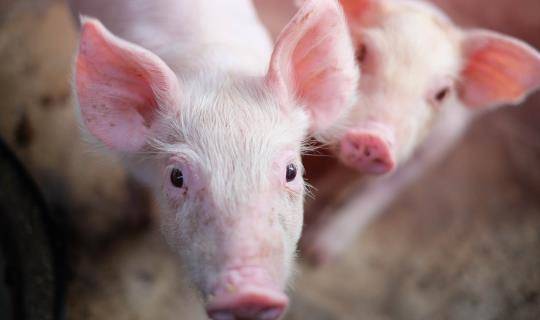Using insect growth regulators in a swine IPM program
By MWI Technical Services

Chemical control is widely used to suppress these pests. However, resistance to conventional insecticides can become problematic and these products are typically only used to target the insect adults. Rather, it’s important to use an integrated pest management (IPM) approach. This incorporates cultural control practices, such as sanitation and insecticide rotation, as well as a variety of chemical control options that target multiple insect life stages. A proper IPM program for swine pests includes surface spraying, baits, knockdown insecticides, and insect growth regulators (IGRs). The focus of this article is the often-overlooked insect growth regulator portion of an IPM program.
What is an IGR?
IGRs are chemical compounds that alter growth and
development in insects by manipulating insect-specific
hormones (Ware and Whitacre, 2004). They are an effective
tool for controlling insect populations because they prevent
insects from reaching their reproductive stage (adults). In
animal production, there are essentially two types of IGRs
available: juvenile hormone analogs and chitin synthesis
inhibitors.
Juvenile hormone analogs (pyriproxyfen). This type of IGR mimics the hormone that keeps an insect from molting, therefore preventing their metamorphosis into the next larval instar or into the pupal stage. Oftentimes, immature insects treated with juvenile hormone analogs will produce seemingly extra-large larvae and nymphs. This occurs because their growth continues inside their confining exoskeleton. The membranes that connect their sclerites (body segments) stretch to their maximum limits and, at this point, the larva and nymphs die, essentially being crushed by their own exoskeleton. In addition, Kawada et al. (1992) observed sterility of adult flies and cockroaches subjected to pyriproxyfen, which means fewer viable eggs were produced.
Chitin synthesis inhibitors (cyromazine, diflubenzuron, and novaluron). This type of IGR prevents the proper formation of exoskeleton, which leads to deformed larvae and pupae. Often, immature flies treated with cyromazine produce elongated, cigar-shaped pupae. Donahue et al. (2017) showed that cyromazine treatments completely prevented adult fly emergence from swine manure, in contrast to the untreated controls throughout the experiment’s four-week duration. A laboratory experiment by Cetin et al. 2006 observed greater than 92 percent mortality of larvae when fed a treatment of novaluron.
Some emerging adults showed morphological abnormalities (malformations of wing, leg, head, thorax, and abdomen) at these concentrations. When larvae were fed a high dose of novaluron, they completed only the first instar and died during ecdysis (molting).
What is the difference between an IGR and a larvicide?
It is important to note that there is a difference between an IGR and a larvicide. The term “larvicide” simply means that the substance kills larvae. Many neurotoxins can make that claim. So, while IGRs are larvicides, not all larvicides are IGRs.
When should IGRs be applied?
IGRs should be applied at the onset of the detection of insects. This requires a method of monitoring for pest populations. Visibly scouting for insect pest activity can be effective if routinely executed and the surveyor knows where to look for pests. Traps can be a more useful tool for scouting and can serve to quantify changes in population densities. Implementing a pest management strategy when insect pests are first detected increases the potential for program success. It is much easier to manage a low insect population density than to remediate a high insect population.
The equipment used for IGR application depends on product formulation. Liquid formulations [Table 1] such as Tekko™ 10 and NyGuard® are mixed with water and sprayed onto breeding sites. Breeding sites are insect species-specific. For example, filth flies spend their immature stages in manure and wet feed. Mosquitoes lay eggs in, as well as complete their immature stages in, stagnant water. Cockroaches, on the other hand, breed in cracks and crevices. Unlike filth flies and mosquitoes, immature stages of molting cockroaches run around in the same environment as adults. So, while you wouldn’t apply IGRs to walls and floors for flies, you would for cockroaches. Liquid sprays can be applied using equipment such as skid sprayers, backpack sprayers, hand-held pump sprayers, or backpack mist blowers such as STIHL® SR-250s or 450s.
Granular formulations [Table 1] like Neporex® and Exhalt® can be applied using broadcast spreaders or STIHL SR- 450s. Depending on slat construction, granules may need swept down into the pit after broadcasting. While granules are more applicable to fly pest management, these formulations can also be mixed with water and sprayed as a liquid.
Feedthrough formulations [Table 1] such as Clarifly® Larvicide are, perhaps, the most efficient IGR application. The mill mixes this product into swine feed and it requires no other labor thereafter. Once a pig consumes the treated feed, the diflubenzuron passes through its system and is excreted in its feces. Susceptible flies are not able to reproduce in the manure. These formulations can be fed continuously throughout the fly season; it’s important to note that IGRs need to be rotated every 6–12 months in order to preserve efficacy (i.e., prevent the development of resistance).
IGRs are not typically used as a standalone treatment because they do not provide instant gratification: It usually takes at least one week to notice their effects that prevent immature insects from reaching the adult stage. In comparison, residual surface spraying results in several weeks of mortality for all life stages of insects that land or crawl across treated surfaces; baits attract and kill their target organisms (i.e., flies, cockroaches) after consumption. Knockdown fogging/misting of natural pyrethrins provides the most instant gratification of adult insect “blooms” (a sudden increase in population).
A combination of these techniques will assuredly result in the most satisfactory pest management program. IGR formulations are effective tools that, if rotated appropriately, can be incorporated into integrated pest management strategies for all insect pest suppression.







